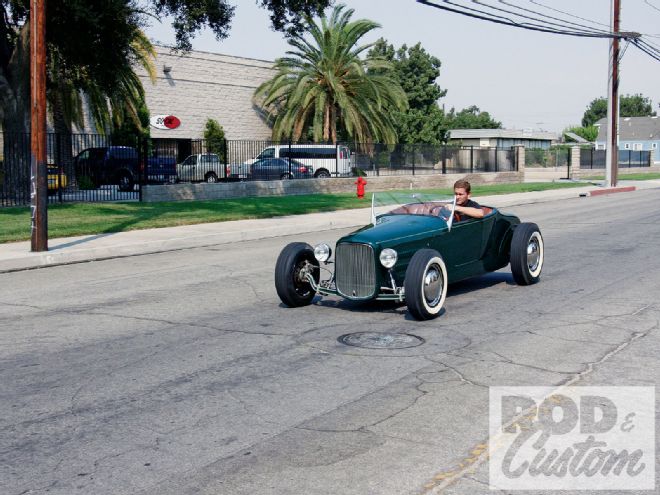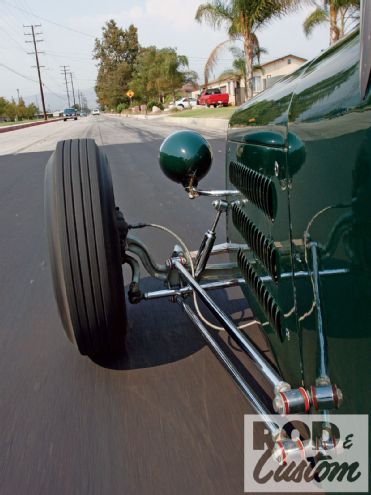
As hot rodders many of us are constantly messing with our cars, swapping induction systems, wheels, and so on ... because they're never really finished, right? So why is it some components fall into the fit-and-forget category? One of the biggest offenders here is the humble shock absorber, which is a little odd considering what an impact it has on a car's handling. You may have owned your car for a few years, and when it's not being used it probably just sits in the garage, right? Or you may have bought the car already built and not know how old the components are. Apart from checking fluids and maybe changing tires when they wear, your hot rod or custom may not get the regular servicing your daily driver probably enjoys, and those shock absorbers are just there. They don't appear to be wearing out and you can't really feel them getting worse, but they do wear out, and the difference a new set makes can be dramatic.

While the springs absorb the jarring motion caused when a car travels over rough ground, the shock absorbers dampen the motion, preventing the springs from continuing to move up and down. Old shocks that no longer offer this damping reduce the contact area the tire has on the road, adversely affecting handling and braking. However, new shock absorbers won't cure excessive wheel hop or skittish handling on their own. Check to make sure that your spring rates are a match for your car's weight before selecting new shock absorbers. Many hot rods are light, especially on the rearend, and if you're running a transverse spring you may find removing a few leaves will improve the ride first. You can check how hard your suspension is by putting a zip tie on the shaft of your shocks where it enters the body (or use plumber's pipe insulation or rollcage padding on the body of a shielded shock where it enters the shield) then take a quick drive and check how far the zip tie or foam has moved. Less than 1 inch of movement will confirm the springs are too stiff. You may also want to check the spring shackles to make sure they're not binding too, as this won't let the spring do its job properly.
OK, back to shock absorbers. A simple test of whether they're working correctly is to push down on the bumper or body. If it rebounds and stops moving quickly the shocks are good, but if it continues to bounce, they'll need replacing. Alternatively, remove them from the vehicle, and if they don't return to full length after you compress them, they're worn out and are effectively doing nothing to damp the suspension movement. This was the situation we found with Pete Chapouris' father's T roadster when we paid a visit to SO-CAL Speed Shop recently. Having just released their New Traditionalist line of steel Speedshocks, the T proved an ideal testbed for this feature, as it is typical of many hot rods in that it gets driven, and driven hard, but infrequently, and receives little maintenance between times. Everyone involved was surprised at just how bad the old shocks were, and what a difference fitting new ones made to the rod's handling.
The T is a very lightweight car, with a V-6 up front and virtually no weight over the rearend. Handed the keys for a testdrive, we went out and found some bumpy roads as well as a few curves to test road holding, body roll, and wheel hop. The first two weren't so bad, given that this is a beam axle-equipped rod, though body roll could've been slightly better, but braking hard on a bumpy road surface found the rear wheels skipping and the tires chirping. Back at the shop, the T went up on the rack, and all four shocks were changed for New Traditionalist chrome shocks, using the new belled cover design on the rear. Out on the road again, body roll was improved, but braking hard on the same section of road as before found no noise coming from the tires. Our conclusion from this not-so-highly scientific test was that the new shocks were doing their job, damping the suspension over the bumps and keeping the tires in contact with the road, in turn improving the handling and making the car safer.
Of course not all rods and customs use tube shocks. While some lightweight rods, such as Model Ts and even As, use friction shocks, a greater number still use lever arm shocks, which after all were original equipment until the late-'40s on Fords. We covered swapping from lever arm to tube shocks on a '36 Ford in our March '08 issue, as well as looking at how stock lever arm shocks were rebuilt back in December '07, both of which will offer the same improvement in ride quality and road holding as fitting new tube shocks. There's little doubt that tube shocks offer the best handling, especially given the availability of adjustable or variable rate versions, both manual and electronically controlled, as well as the patented rising-rate valving available in Bilstein shock absorbers. But sometimes, lever arm shocks are more suitable for the build style of a car, the choice coming down to personal preference. Whichever style appeals to you, now may be the time to take a look at your shock absorbers.